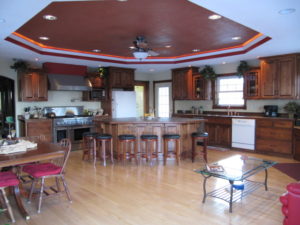Grant Writing = Remodeling: Need or Want?
This is the sixth of a series of posts comparing grant writing to house remodeling.
As mentioned in an earlier post, remodeling and grant writing are not linear processes. As you are doing your research, conducting your assessments, and developing your strategic plan, you will begin the process of creating your program and identifying your wants and needs.
While doing research, Kevin and I conducted an assessment of our needs and wants. We drew up our master remodel plan and divided the remodel project into three phases (strategic plan). We determined the most important need we had was remodeling the kitchen. That was Phase One, and where I will focus for this piece. Once we decided the kitchen remodel was the highest priority, we looked at elements – the needs and wants – of the kitchen remodel (objectives and strategies). Below are a few examples of the needs and wants we addressed.
We wanted a larger kitchen/dining area and our assessment supported that we needed a larger kitchen/dining area. We like to cook, bake, can the fruits of our garden, and entertain. The original kitchen was so small that it was crowded with two people! And where do people hang out when they come over – the kitchen. The adjacent dining area was barely large enough for a table with four chairs. In this situation the want and need were both supported by our assessment– we added on to the house.
In assessing the appliances, we wanted all new appliances. However, to stay within the budget, we determined that the only appliance that needed updating was the stove.
We wanted cherry cabinets, but only needed cabinets that were of good quality. Through research we found a cost effective way to have quality cabinets that had a unique design and looked like antiqued cherry. In fact, the company that made our cabinets added them to their selection, and is a popular choice for their customers.
We wanted granite counter tops, but needed to stay within the budget. We chose tile. We receive lots of compliments on both the cabinets and tile counter top!
While doing your research and developing your strategic plan, a needs assessment needs to be done to ensure you are addressing the real needs, and not perceived needs. Just as Kevin and I worked together to determine our needs and wants, it is important to include all who are part of your organization in determining the real needs and of course, their wants. You will want to include your clients, staff, board members, other organizations who provide services similar to your organization, government and more. It is important to learn directly from the clients you serve what they believe are their needs – do not assume you know their needs, or wants. Nor assume which need is the priority. Learn from your constituents. Below are a few examples of needs and wants.
The library wanted to purchase ten new computers. However to stay within the budget they determined that five computers sufficiently met the need.
The organization wanted a van to transport its clients to the main building. After the assessment of its clients, the need was to meet with clients at their home.
XYZ non-profit wanted and needed to hire five tutors. To stay within budget, they researched and collaborated with the library to share resources. This has become a model program for similar non-profits.
Discerning your need from your wants helps ensure an effective use of resources and the budget; something funders always look for in the programs they fund.



